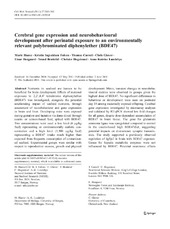Cerebral gene expression and neurobehavioural development after perinatal exposure to an environmentally relevant polybrominated diphenylether (BDE47)
Haave, Marte; Folven, Kristin Ingvaldsen; Carroll, Thomas; Glover, Chris; Heegaard, Einar; Brattelid, Trond; Hogstrand, Christer; Lundebye, Anne-Katrine
Peer reviewed, Journal article
Published version
Permanent lenke
http://hdl.handle.net/1956/5224Utgivelsesdato
2011-06-02Metadata
Vis full innførselSamlinger
Sammendrag
Nutrients in seafood are known to be beneficial for brain development. Effects of maternal exposure to 2,2′,4,4′ tetrabromo diphenylether (BDE47) was investigated, alongside the potential ameliorating impact of seafood nutrients, through assessment of neurobehaviour and gene expression in brain and liver. Developing mice were exposed during gestation and lactation via dams dosed through casein- or salmon-based feed, spiked with BDE47. Two concentrations were used: a low level (6 μg/kg feed) representing an environmentally realistic concentration and a high level (1,900 μg/kg feed) representing a BDE47 intake much higher than expected from frequents consumption of contaminated seafood. Experimental groups were similar with respect to reproductive success, growth and physical development. Minor, transient changes in neurobehavioural metrics were observed in groups given the highest dose of BDE47. No significant differences in behaviour or development were seen on postnatal day 18 among maternally exposed offspring. Cerebral gene expression investigated by microarray analyses and validated by RT-qPCR showed low fold changes for all genes, despite dose-dependent accumulation of BDE47 in brain tissue. The gene for glutamate ammonia ligase was upregulated compared to control in the casein-based high BDE47diet, suggesting potential impacts on downstream synaptic transmission. The study supported a previously observed regulation of Igfbp2 in brain with BDE47 exposure. Genes for hepatic metabolic enzymes were not influenced by BDE47. Potential neurotoxic effects and neurobehavioural aberrations after perinatal exposure to high levels of BDE47 were not readily observed in mice pups with the present experimental exposure regimes and methods of analysis.

